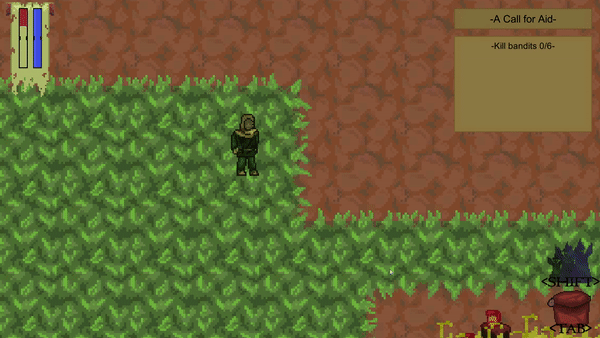Bygone
Bygone is a story-driven RPG following an exiled mage. In it's current state, the game utilizes a text-based quest system, a variety of AI algorithms, and data persistence. Each provided their own challenges, though data persistence was definitely the most challenging to get right.

Text-based Quest System
-
The quest system reads a text document of quest data and parses it into Quest Objects for in-game use
-
Quest data is designed to keep track of quests and individual quest steps with ID values, so the system can check if pre-prerequisite quests have been completed or know which quest step to jump to
-
The system supports AND/OR quest steps which allow quests to either do one required action or all required actions
-
Quest steps can be flagged as hidden so the player will not be able to see them in game
-
-
Future goals of this system is to support more quest variants and more general results/requirements
-
Radiant quests to allow a repeat objective with randomized targets
-
Pre-reqs and results to include faction reputation, morality, or other general game-specific mechanics
-

Modular AI and AI Algorithms
-
AI is modularly made, so that as I update different aspects of AI, I can update and replace components with either improved versions or new components
-
Movement is generally based around a generated nodemap for each level, and npc's do A* pathfinding to reach their goal
-
AI modules include targeting patterns, attack variations, movement types, or scene driven.
-
AI is broken into having a movement component and attack component so that different permutations of AI combatants is possible
-
-
AI Interaction
-
AI will behave with the player either automatically aggressive or based on reputation with their faction
-
AI can choose to target npc's instead of the player depending on module setup, specified target, and perceived threat
-

Data Persistence Challenges
-
Goal
-
I wanted AI to save between scenes in Unity, so that if they were chasing you in scene 1, and you left then came back they'd still be in the same position they were left.
-
-
Problem
-
Unity doesn't allow serialization of game objects, so I cannot just save a JSON and reload the JSON file
-
NPC's will differ on reloading based on whether they were spawned in algorithmically or placed in the world manually
-
-
Solution
-
Created a dictionary to store NPC prefabs and tied them into an NPC ID so I can recreate new copies of the NPC when reloading
-
To handle the difference between spawned and placed NPC's, I created instance id's and instantiation types to delineate between each individual NPC and their needs and would store that in a dictionary
-
For manually placed NPC's, I would check against the stored dictionary and see if an npc from that level, with matching start data, was in the dictionary and if it was, replace it with the dictionary version
-
Conversion to 3D
-
Limits on pixel art efficiency made me decide to switch the game to 3D
-
Currently have created a 3D movement system I like
-
Character movement uses quaternions to align to the camera direction, from a third person view
-
Player base movement, once camera is accounted for, is then adjusted to match the incline of the surface
-
Uses the normal of the collision point to create an orthogonal vector that I can project the base movement onto
-
Ensures that player can reach maximum speed regardless of incline they are on
-
-
Player can double jump, and use their second jump to change direction in midair
-
